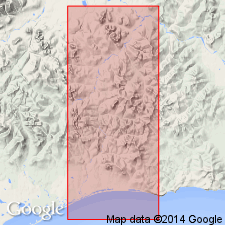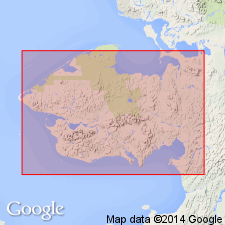
- Usage in publication:
-
- Hurrah slate*
- Modifications:
-
- Named
- Dominant lithology:
-
- Slate
- Quartzite
- Limestone
- AAPG geologic province:
-
- Seward Peninsula province
- Alaska West-Central region
Summary:
Named for exposures in lower 2 or 3 mi of Big Hurrah Creek and in shafts of Big Hurrah mine at junction of Big and Little Hurrah Creeks, Solomon quad, Seward Peninsula, west-central AK. Mapped in Casadepaga and Solomon quads. Is part of Nome group of earlier geologists which covered three-quarters of land area of quads. Consists of carbonaceous quartzites and black slate with basal few ft to 50 ft of black nondolomitic limestone locally. Is approximately 200 to 800 ft thick. Overlies Sowik limestone (new) and Solomon schist (new). Contains no fossils. Assigned to post-Ordovician(?) age.
Source: GNU records (USGS DDS-6; Menlo GNULEX).

- Usage in publication:
-
- Hurrah Slate*
- Modifications:
-
- Age modified
- AAPG geologic province:
-
- Seward Peninsula province
- Alaska West-Central region
Summary:
Age of Hurrah Slate in Solomon and Casadepaga area is Precambrian based on probable correlation with slate, graphitic siltite, and quartz mica schist of York region in western Seward Peninsula. (Shown on generalized geologic sketch map of Seward Peninsula as of late Precambrian age). These graphitic or slaty rocks exhibit common characteristics of being composed principally of silt-size quartz grains in graphitic matrix. Disparity in degree of deformation between Nome Group rocks and slates of York region suggests that slates are unconformable above Nome Group.
Source: GNU records (USGS DDS-6; Menlo GNULEX).
For more information, please contact Nancy Stamm, Geologic Names Committee Secretary.
Asterisk (*) indicates published by U.S. Geological Survey authors.
"No current usage" (†) implies that a name has been abandoned or has fallen into disuse. Former usage and, if known, replacement name given in parentheses ( ).
Slash (/) indicates name conflicts with nomenclatural guidelines (CSN, 1933; ACSN, 1961, 1970; NACSN, 1983, 2005, 2021). May be explained within brackets ([ ]).

